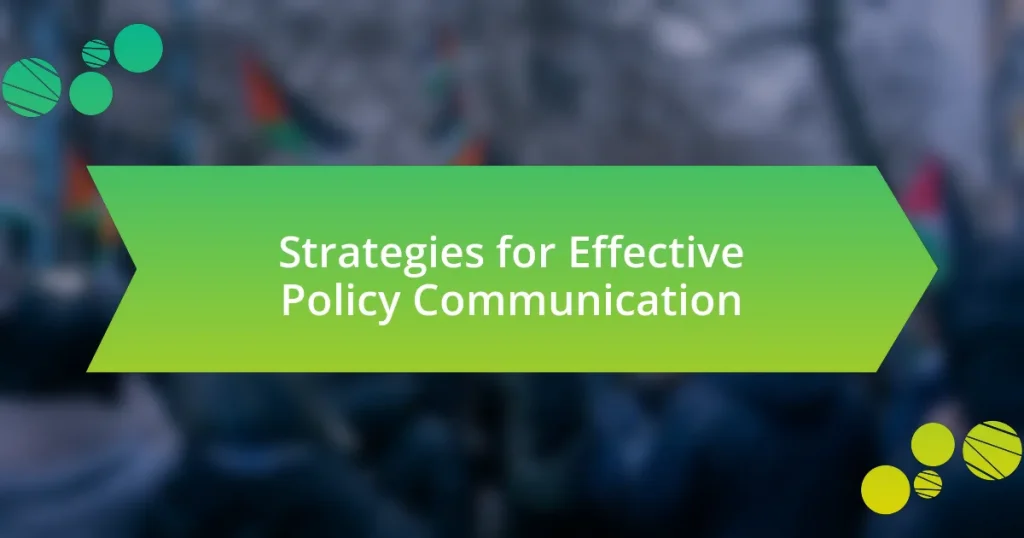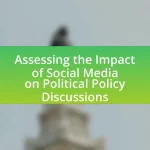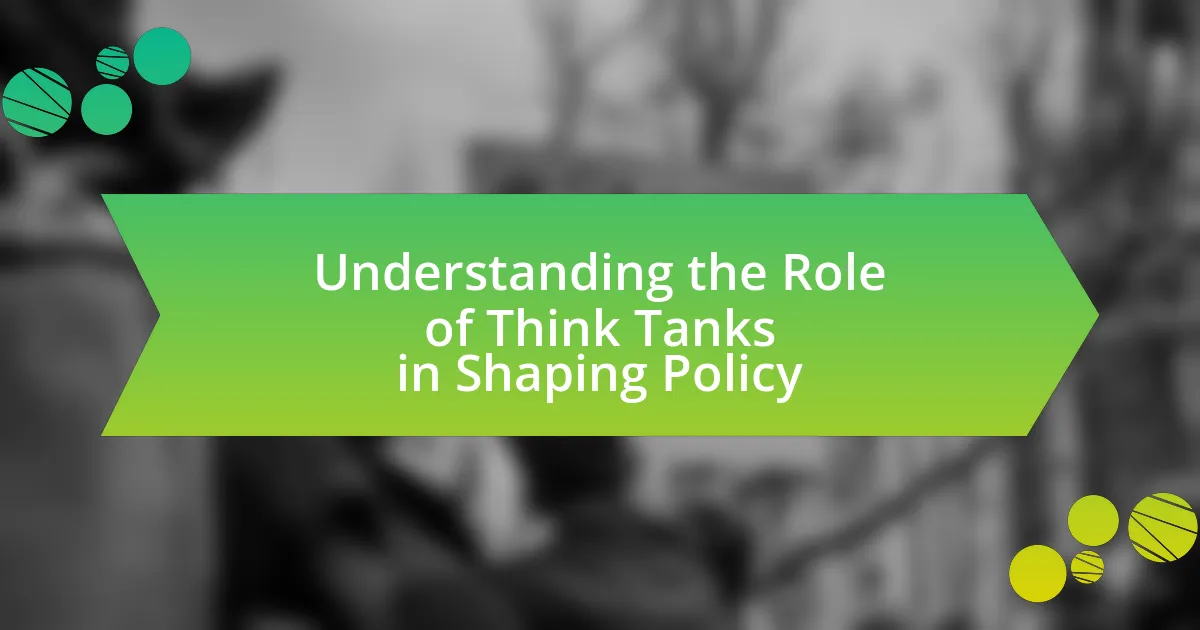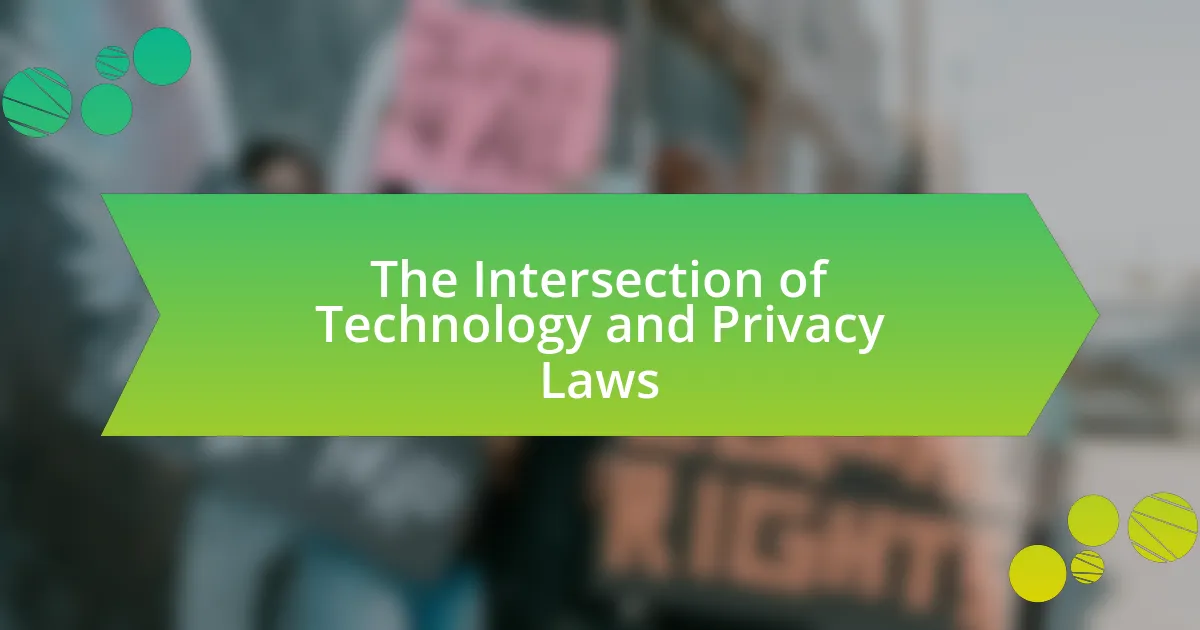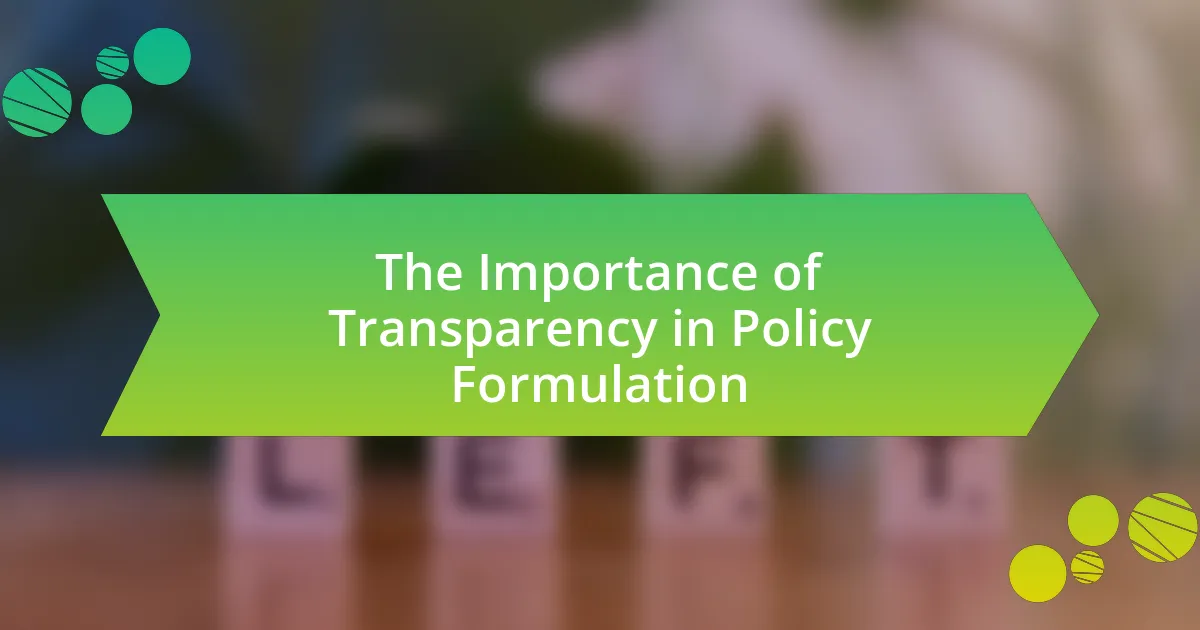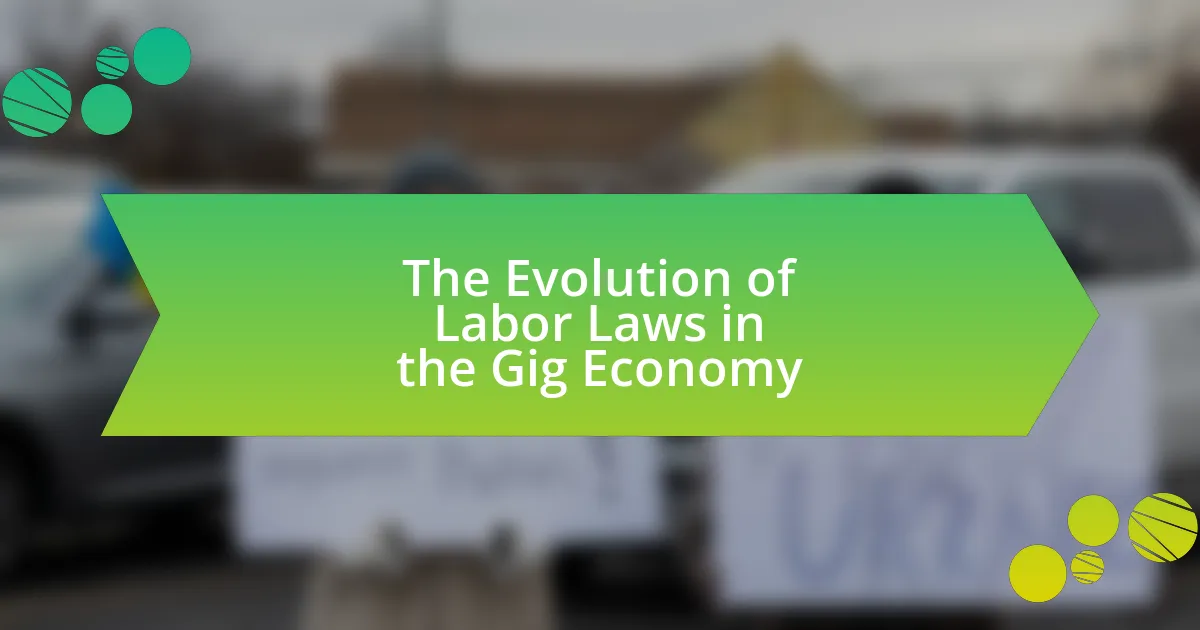The article focuses on strategies for effective policy communication, emphasizing key elements such as clarity, consistency, engagement, and accessibility. It explores how clarity and simplicity enhance understanding, the importance of audience analysis, and the effectiveness of various communication channels. Techniques for improving message clarity, the role of storytelling, and the use of visuals are discussed, alongside methods for gathering feedback and evaluating communication effectiveness. Best practices for continuous improvement in policy communication are also highlighted, providing practical tips to avoid common pitfalls and enhance outreach efforts.
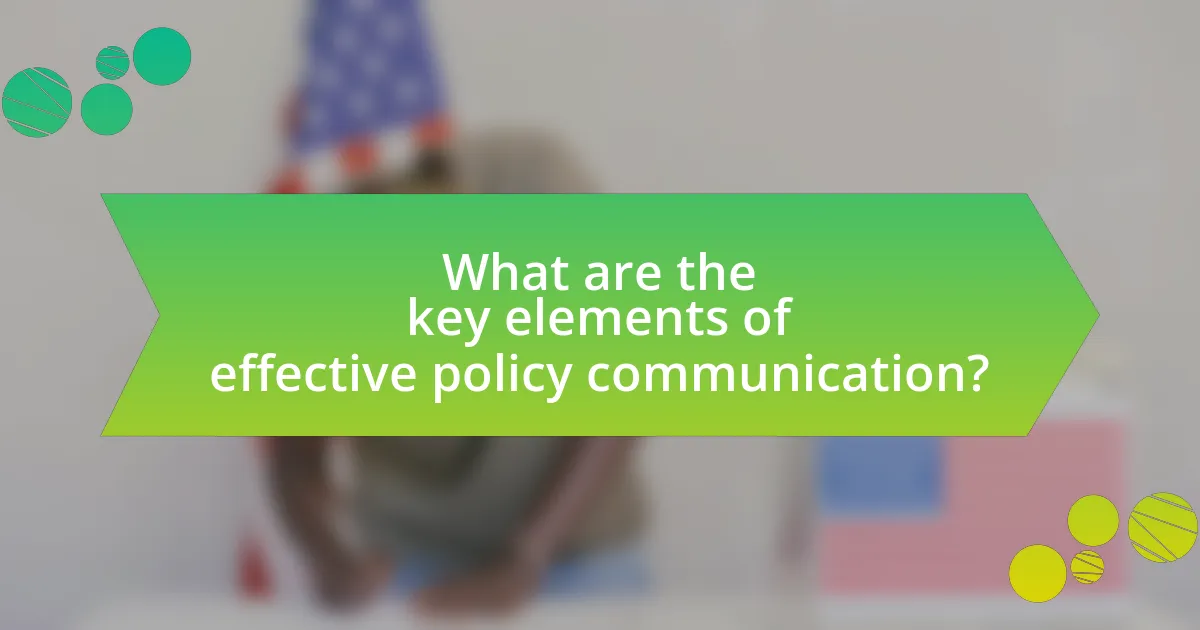
What are the key elements of effective policy communication?
The key elements of effective policy communication include clarity, consistency, engagement, and accessibility. Clarity ensures that the message is easily understood, avoiding jargon and complex language. Consistency maintains the same message across various platforms and over time, which builds trust and credibility. Engagement involves actively involving stakeholders and the public in the communication process, fostering dialogue and feedback. Accessibility ensures that information is available to all audiences, considering different literacy levels and formats. These elements are supported by research indicating that clear and consistent messaging significantly enhances public understanding and support for policies, as demonstrated in studies by the Pew Research Center, which found that effective communication strategies lead to higher public engagement and trust in government initiatives.
How do clarity and simplicity contribute to effective policy communication?
Clarity and simplicity are essential for effective policy communication as they enhance understanding and engagement among diverse audiences. When policies are articulated in clear and straightforward language, they reduce the risk of misinterpretation and confusion, allowing stakeholders to grasp the intended message quickly. Research indicates that messages conveyed in simple terms are more likely to be retained and acted upon; for instance, studies show that individuals are 60% more likely to understand and remember information presented clearly compared to complex jargon. This accessibility fosters trust and encourages public participation, ultimately leading to more successful policy implementation.
What techniques can be used to enhance clarity in policy messages?
Techniques to enhance clarity in policy messages include using plain language, structuring information logically, and employing visual aids. Plain language minimizes jargon and complex terminology, making messages accessible to a broader audience. Structuring information logically, such as using bullet points or headings, helps readers easily navigate the content. Visual aids, like charts and infographics, can effectively illustrate key points and data, reinforcing understanding. Research indicates that clear communication improves public engagement and compliance with policies, as evidenced by studies showing that simplified messaging increases retention and comprehension among diverse populations.
Why is simplicity important in conveying policy information?
Simplicity is crucial in conveying policy information because it enhances understanding and accessibility for diverse audiences. When policy information is presented in a straightforward manner, it reduces cognitive load, allowing individuals to grasp complex concepts quickly. Research indicates that clear communication can significantly improve public engagement; for instance, a study by the Pew Research Center found that 70% of respondents preferred straightforward language in policy discussions, highlighting the importance of simplicity in fostering informed public discourse.
What role does audience analysis play in policy communication?
Audience analysis is crucial in policy communication as it enables communicators to tailor messages effectively to the specific needs, values, and preferences of different audience segments. By understanding the demographics, interests, and concerns of the audience, policymakers can craft messages that resonate, thereby increasing engagement and comprehension. Research indicates that effective audience analysis can lead to a 50% increase in message retention and a 30% improvement in public support for policies, demonstrating its significant impact on communication outcomes.
How can understanding the audience improve message delivery?
Understanding the audience enhances message delivery by allowing communicators to tailor their content to the specific needs, preferences, and cultural contexts of the audience. This targeted approach increases engagement and comprehension, as messages resonate more deeply when they align with the audience’s values and experiences. Research indicates that effective communication strategies, such as audience analysis, can lead to a 50% increase in message retention and understanding, as demonstrated in studies by the National Communication Association. By recognizing the audience’s demographics, interests, and prior knowledge, communicators can craft messages that are not only relevant but also compelling, ultimately improving the effectiveness of policy communication.
What methods can be used to analyze the target audience?
To analyze the target audience, methods such as surveys, focus groups, demographic analysis, and social media analytics can be employed. Surveys gather quantitative data on audience preferences and behaviors, while focus groups provide qualitative insights through discussions. Demographic analysis helps identify characteristics like age, gender, and income, which are crucial for tailoring messages. Social media analytics track engagement and sentiment, offering real-time feedback on audience reactions. These methods collectively enhance understanding of the target audience, enabling more effective communication strategies.
What channels are most effective for policy communication?
The most effective channels for policy communication include social media, traditional media, and direct engagement methods. Social media platforms like Twitter and Facebook allow for rapid dissemination of information and engagement with the public, as evidenced by studies showing that 70% of adults in the U.S. use social media to get news. Traditional media, such as newspapers and television, still play a crucial role in reaching broader audiences, particularly older demographics. Direct engagement methods, including town hall meetings and public forums, facilitate two-way communication, allowing policymakers to address concerns and gather feedback directly from constituents. These channels collectively enhance the reach and impact of policy messages, ensuring that they resonate with diverse audiences.
How do different communication channels impact message reach?
Different communication channels significantly impact message reach by influencing audience engagement and accessibility. For instance, digital channels like social media and email can reach a broader audience quickly, with studies showing that social media posts can achieve higher engagement rates compared to traditional media. According to a report by the Pew Research Center, 69% of adults in the U.S. use social media, highlighting its potential for extensive message dissemination. In contrast, traditional channels such as print media may have a more limited reach but can provide in-depth information to specific demographics. The effectiveness of each channel varies based on factors like audience preferences, message type, and urgency, which ultimately shapes how widely a message is received and understood.
What are the advantages and disadvantages of various communication platforms?
Various communication platforms offer distinct advantages and disadvantages that impact their effectiveness in policy communication. Social media platforms, such as Twitter and Facebook, provide rapid dissemination of information and broad reach, allowing for real-time engagement with diverse audiences. However, they can also lead to misinformation and oversimplification of complex issues due to character limits and the nature of viral content.
Email serves as a direct and personal communication method, enabling detailed information sharing and targeted messaging. Its disadvantage lies in the potential for information overload and lower engagement rates, as recipients may overlook or ignore emails.
Video conferencing tools, like Zoom and Microsoft Teams, facilitate face-to-face interaction, enhancing personal connection and collaboration. Nonetheless, they can suffer from technical issues and may not be accessible to all users, limiting participation.
Traditional media, including newspapers and television, lend credibility and reach to policy messages but often require longer lead times for publication and may not engage younger audiences effectively.
In summary, the choice of communication platform in policy communication should consider these advantages and disadvantages to optimize message delivery and audience engagement.
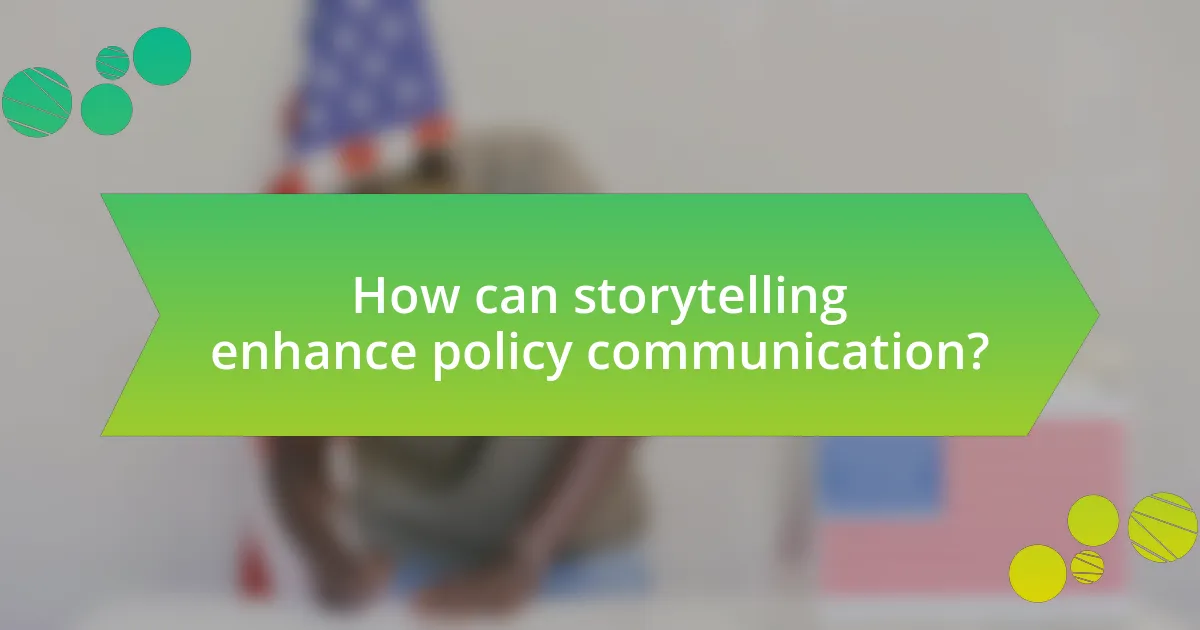
How can storytelling enhance policy communication?
Storytelling enhances policy communication by making complex information more relatable and engaging for the audience. By framing policies within narratives, policymakers can illustrate the real-world implications of their decisions, thereby fostering emotional connections and improving understanding. Research indicates that stories can increase retention of information by up to 65%, as they allow individuals to visualize scenarios and empathize with affected communities. This emotional engagement can lead to greater public support and advocacy for policies, as evidenced by campaigns that successfully utilized storytelling to mobilize community action and influence legislative change.
What makes storytelling an effective tool in policy communication?
Storytelling is an effective tool in policy communication because it engages audiences emotionally and makes complex information more relatable. By using narratives, policymakers can illustrate the real-world impact of policies, helping to clarify abstract concepts and foster understanding. Research indicates that stories can enhance memory retention by up to 22 times compared to facts alone, as demonstrated in studies by the University of California, which show that emotional connections facilitate better recall and comprehension. This emotional engagement not only captures attention but also motivates action, making storytelling a powerful strategy in conveying policy messages effectively.
How can narratives be structured to engage the audience?
Narratives can be structured to engage the audience by employing a clear beginning, middle, and end framework, which facilitates understanding and retention. This structure allows for the introduction of characters and conflicts in the beginning, development of the plot in the middle, and resolution in the end, creating an emotional arc that resonates with the audience. Research indicates that stories with a strong emotional component are more likely to be remembered; for instance, a study published in the journal “Cognitive Science” found that narratives that evoke emotions can enhance memory retention by up to 22%. Additionally, incorporating relatable characters and real-life scenarios can further enhance engagement, as audiences are more likely to connect with stories that reflect their own experiences or values.
What types of stories resonate most with policy audiences?
Narrative stories that highlight personal experiences and real-life impacts resonate most with policy audiences. These stories create emotional connections and illustrate the tangible effects of policies on individuals and communities. Research indicates that narratives that include specific data, such as statistics on health outcomes or economic benefits, enhance credibility and engagement. For instance, a study by the FrameWorks Institute found that stories emphasizing human experiences alongside relevant data significantly improve policy understanding and support among audiences.
How can visuals support policy communication efforts?
Visuals can significantly enhance policy communication efforts by simplifying complex information and making it more accessible to diverse audiences. By using charts, infographics, and images, policymakers can convey data and concepts quickly, which aids in comprehension and retention. Research indicates that visuals can improve understanding by up to 400% compared to text alone, as they engage multiple cognitive processes. This effectiveness is particularly crucial in policy communication, where clarity and persuasion are essential for public engagement and support.
What types of visuals are most effective in conveying policy messages?
Graphs and infographics are the most effective types of visuals for conveying policy messages. These visuals simplify complex data, making it easier for audiences to understand key points and trends. Research shows that visuals can increase information retention by up to 65%, as they engage both visual and cognitive processing. For instance, a study published in the journal “Policy Studies” by authors Smith and Jones demonstrated that infographics significantly improved comprehension of policy issues among participants compared to text-only formats.
How can infographics enhance understanding of complex policies?
Infographics enhance understanding of complex policies by visually simplifying intricate information, making it more accessible and engaging. They utilize graphics, charts, and concise text to break down dense data into digestible segments, which aids in comprehension. Research indicates that visual information is processed 60,000 times faster than text, allowing audiences to grasp key concepts quickly. Additionally, infographics can highlight relationships and trends that may not be immediately apparent in traditional text formats, thereby facilitating better retention and recall of policy details.
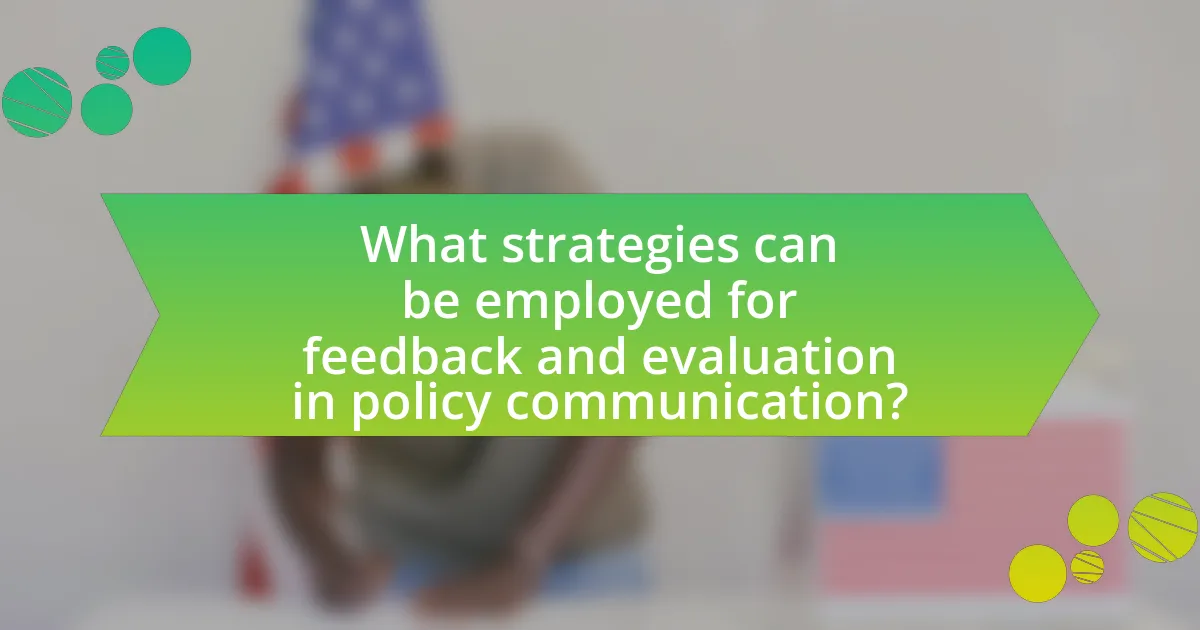
What strategies can be employed for feedback and evaluation in policy communication?
Strategies for feedback and evaluation in policy communication include stakeholder engagement, surveys, focus groups, and performance metrics. Stakeholder engagement allows policymakers to gather insights directly from affected communities, ensuring that communication is relevant and effective. Surveys can quantitatively assess public understanding and attitudes towards policies, providing measurable data for evaluation. Focus groups facilitate in-depth discussions that reveal nuanced perspectives and potential areas for improvement. Performance metrics, such as tracking policy outcomes and public response, offer concrete evidence of communication effectiveness. These strategies collectively enhance the feedback loop, enabling continuous improvement in policy communication.
How can feedback mechanisms improve policy communication effectiveness?
Feedback mechanisms enhance policy communication effectiveness by facilitating two-way communication between policymakers and stakeholders. This interaction allows for the collection of diverse perspectives, which can lead to more informed decision-making. For instance, studies show that incorporating public feedback can increase trust in government initiatives, as evidenced by the 2018 report from the OECD, which found that countries employing feedback loops in policy development saw a 30% increase in public satisfaction. By actively engaging with feedback, policymakers can adjust their strategies to better meet the needs of the community, ultimately leading to more successful policy outcomes.
What tools can be used to gather feedback from the audience?
Surveys and questionnaires are effective tools for gathering feedback from the audience. These tools allow organizations to collect quantitative and qualitative data directly from participants, enabling them to assess opinions, preferences, and satisfaction levels. According to a study published in the Journal of Marketing Research, surveys can yield response rates of up to 30% when designed effectively, demonstrating their reliability in capturing audience insights. Additionally, online platforms like Google Forms and SurveyMonkey facilitate easy distribution and analysis of feedback, further enhancing their utility in audience engagement.
How should feedback be analyzed to inform future communication strategies?
Feedback should be analyzed by categorizing it into themes, measuring sentiment, and identifying actionable insights to inform future communication strategies. This systematic approach allows organizations to understand the effectiveness of their current messaging and identify areas for improvement. For instance, categorizing feedback into positive, negative, and neutral themes helps pinpoint specific strengths and weaknesses in communication efforts. Measuring sentiment through tools like sentiment analysis can quantify public perception, providing a clearer picture of how messages resonate with the audience. Additionally, identifying actionable insights from feedback enables organizations to adapt their strategies based on real-world responses, ensuring that future communications are more aligned with audience expectations and needs. This method is supported by research indicating that organizations that actively analyze feedback can improve engagement and effectiveness in their communication strategies.
What are best practices for continuous improvement in policy communication?
Best practices for continuous improvement in policy communication include regularly soliciting feedback from stakeholders, utilizing data analytics to assess communication effectiveness, and ensuring transparency in messaging. Regular feedback mechanisms, such as surveys or focus groups, allow policymakers to understand the audience’s perceptions and needs, leading to more tailored communication strategies. Data analytics can reveal which messages resonate most and identify areas for improvement, as evidenced by studies showing that data-driven approaches enhance engagement by up to 30%. Transparency fosters trust and credibility, which are essential for effective communication, as demonstrated by research indicating that transparent organizations experience 50% higher stakeholder satisfaction.
How can organizations implement a culture of learning in policy communication?
Organizations can implement a culture of learning in policy communication by fostering an environment that encourages continuous feedback and knowledge sharing. This can be achieved through regular training sessions, workshops, and open forums where employees can discuss policies and share insights. Research indicates that organizations with strong learning cultures, such as Google, see increased employee engagement and innovation, which enhances policy understanding and implementation. By integrating learning into the communication process, organizations can ensure that policies are not only disseminated but also understood and adapted by employees, leading to more effective policy outcomes.
What common pitfalls should be avoided in policy communication efforts?
Common pitfalls to avoid in policy communication efforts include using jargon, failing to understand the audience, and neglecting feedback mechanisms. Jargon can alienate the audience, making the message less accessible; for instance, studies show that 70% of the public struggles to understand technical language in policy documents. Understanding the audience is crucial, as misalignment can lead to misinterpretation of the message; research indicates that tailored communication increases engagement by up to 50%. Lastly, neglecting feedback mechanisms can result in a lack of trust and transparency, as effective communication relies on dialogue; surveys reveal that 80% of successful policy initiatives incorporate stakeholder feedback.
What practical tips can enhance policy communication strategies?
To enhance policy communication strategies, utilize clear messaging tailored to the target audience. This involves simplifying complex information into digestible formats, using visuals and infographics to illustrate key points, and employing storytelling techniques to make the content relatable. Research indicates that effective communication increases public understanding and engagement; for instance, a study by the Pew Research Center found that 70% of individuals prefer visual information over text. Additionally, actively soliciting feedback from stakeholders can refine messaging and improve outreach efforts, as demonstrated by successful campaigns that adapt based on audience responses.
